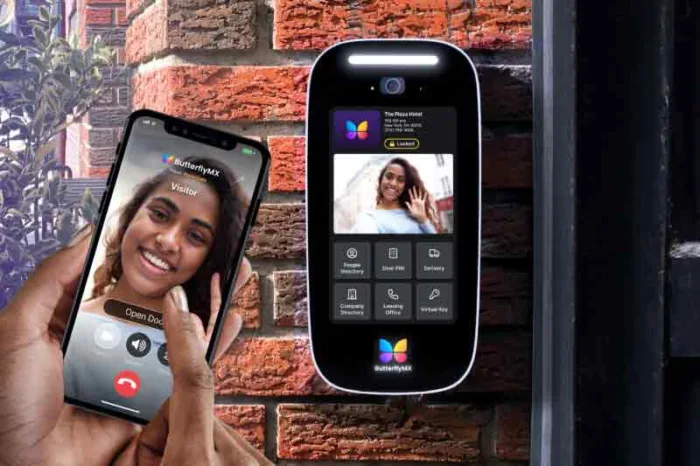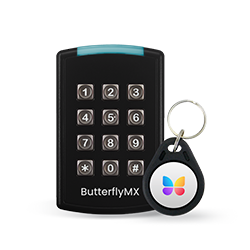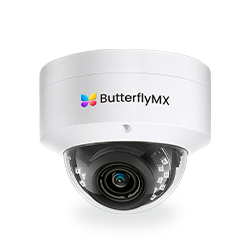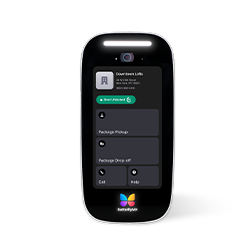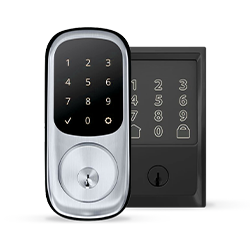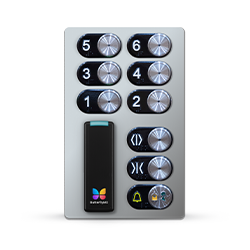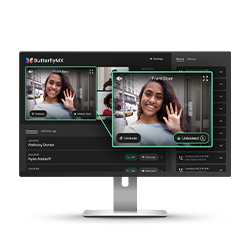Key takeaways:
- A telephone entry system is an electronic device that empowers building residents to communicate with and grant access to their visitors.
- While they enable communication, telephone entry systems lack cameras, they can’t be managed remotely, and they require telephones, which many modern residents lack.
- A video intercom is a modern take on the telephone entry system and the best replacement for your outdated entry system.

Any building with visitors needs a way to manage property access. And one of the oldest types of visitor management systems is the telephone entry system.
For over a century, these systems have been used to manage visitor access into all kinds of buildings, from single-family homes to luxury high-rise apartments. But what are these systems, and what’s the best option for your building?
Read on to learn more about telephone entry systems and how they work. We also explain why an alternative apartment intercom system may be better for your building.
This post covers:
More than 40K, 5-star reviews!
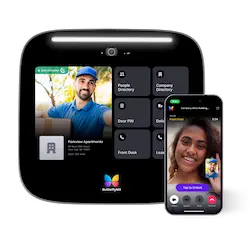
Video Intercoms
Open doors, gates & garages from anywhere.

QR Code Intercom
Smartphone-based visitor access.
Access Control
Fob, key cards, PINs, and mobile apps.
Security Cameras
Visibility throughout your property.
Vehicle Access
Hands-free access for gates & garages.
Package Room
Receive, store, and manage deliveries.
Smart Locks
Connect to all major brands and models.
Elevator Controls
Unlock key-fobbed elevators for anyone.
Front Desk Station
See all your doors and cameras in one place.
5 telephone entry systems
If you intend to purchase a telephone entry system, make sure you choose one that is worth the money.
Here are five telephone entry models to consider:
1. Doorking
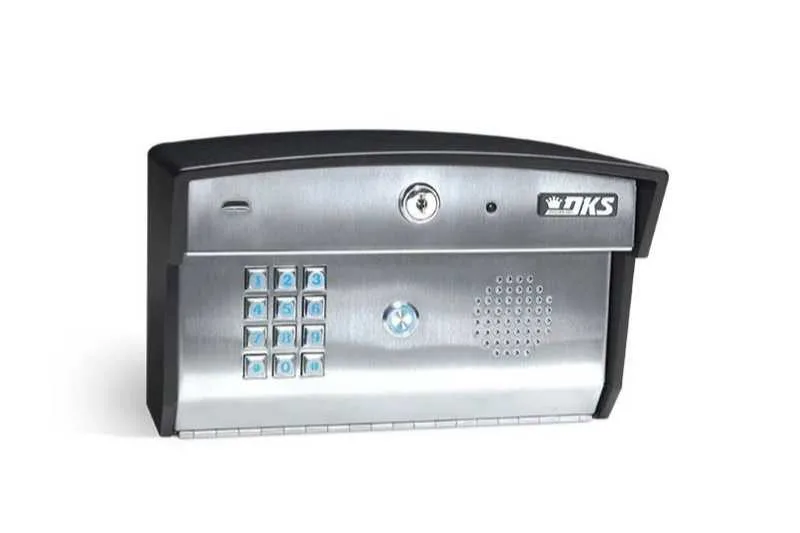
Source: DoorKing
Doorking is perhaps the most well-known telephone entry system provider in the industry. Based in Southern California, Doorking (or DKS) has sold phone entry systems since 1948.
DKS telephone entry models have a traditional, simple design with few features or bells and whistles. These systems are installed on POTS phone lines, requiring traditional telephone wiring. However, Doorking does offer cellular telephone entry models. But to enable cellular service, you must purchase the DKS Cellular Connection Box, which is sold separately from the entry system.
Features of Doorking systems vary by model but may include:
- LED tenant directory
- Ability to store thousands of names and phone numbers
- Programmable via PC (systems include programming software)
- Tamper alert switch
- Weather sealing
According to a January 2022 price sheet, Doorking systems’ hardware costs from $1,496 to $7,040 (depending on model).
Remember to also budget for installation fees and possible service connection costs. A VoIP adapter costs $180, while cellular service connection plans range from $1,200 to $1,700.
2. Kantech

Source: Kantech
Kantech is a Tyco Security Products company founded in 1986 that designs and sells various access control solutions that are ready to use right out of the box. The company’s product lineup ranges from security services and software to door controllers and telephone systems.
The Kantech Telephone Entry System (KTES) is a basic building entry system designed for apartments, gated communities, condos, offices, and industrial properties. Visitors can call and communicate with a tenant directly through the KTES, at this point, the tenant can grant or deny entry directly from a landline telephone or cell phone.
Property staff can remotely manage their building’s KTES using Kantech’s EntraPass software, which appears to be sold separately and may only be compatible with Windows operating systems.
Features of the Kantech telephone entry system:
- Compatibility with Kantech door controllers.
- Comes with a pared-down version of EntraPass management software. So, you may have to purchase the full software package for access to all features.
- Use as a stand-alone system or integrate with an existing access control system.
- Vandal- and weather-resistant stainless steel casing.
- One phone line supports up to five units.
- 4-line, 20-character LCD screen.
- Directory capacity of 3,000 tenants.
3. Mircom

Source: Mircom
Founded by Tony Falbo in 1991 and based in Canada, Mircom is a security and building solutions provider that offers a variety of TCP/IP ready, auto-dial, and NSL (no subscriber line) telephone entry models.
Mircom’s telephone entry system product lineup includes:
- Paper directory systems
- Hands-free electronic directory models
- Slim-line models
- Video telephone access system
- NSL telephone access kits (for buildings without a dedicated phone line or that don’t want to pay for a dedicated phone line)
Mircom phone entry systems are basic property entry solutions designed for apartments, condos, gated communities, offices, and industrial sites.
Mircom system features:
- Option to add key card access and elevator controls
- Electronic or paper directory, depending on the model
- Programmable via the built-in keypad or with a computer via optional TX3 configuration software
- Require a dedicated phone line (for NSL configuration, you’ll need additional hardware such as relay cards and relay cabinets)
Mircom telephone system pricing doesn’t appear to be available on the company’s website, so you may have to contact them to request a quote.
4. Linear
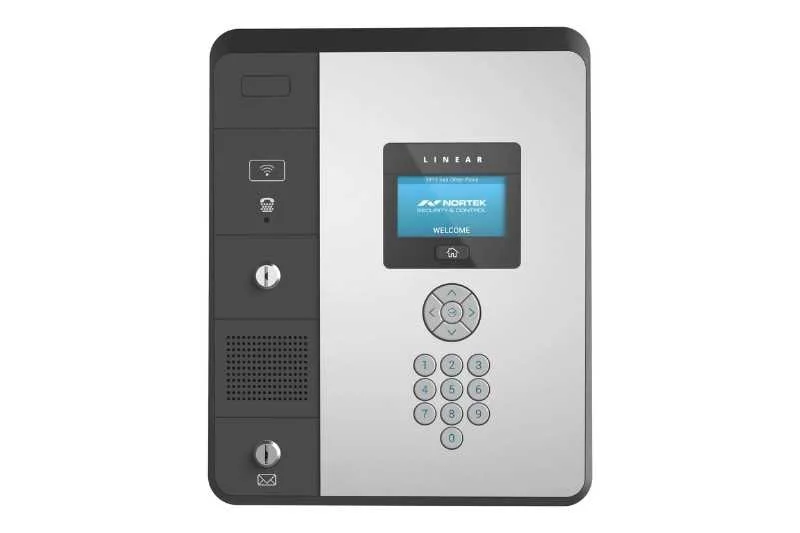
Source: Linear
Founded in 1961, Linear is a well-known access control solutions provider based in Carlsbad, California. The company is part of the Nortek Control family of brands, offering a variety of products including door operators, access control devices, and telephone entry systems.
Linear telephone entry systems can be programmed locally using the system’s keypad. But remote management and programming vary by model. For example, the AE-100 can only be programmed remotely via a touch-tone telephone. But the EP-402 may be fully browser-managed.
Features of Linear tele entry systems:
- Built-in keypad on all models
- Electronic directory with navigation buttons (plus one touchscreen model)
- Number of doors supported varies by model (1-, 2-, or 36-door models)
- Most basic model allows up to 125 tenants; other models may have greater directory capacity
- Accessories sold separately, including add-on camera, metal trim rings, and pedestal mounts.
5. Select Engineered Systems

Source: Select Engineered Systems
Select Engineered Systems (SES) develops and offers cost-effective, scalable access control solutions. The company was founded in 1976 but incorporated as Select Engineered Systems in 1980, and is today based in Florida.
SES offers various products, including help communication systems, card entry systems, building communication systems, and digital keypads. However, it primarily focuses on tele-entry systems.
Select Engineered Systems offers two system models: the TEC1 basic and TEC2 series.
SES telephone entry system features:
- 2-, 4-, or 10-line LCD display
- Five tenant directory capacities: 50, 125, 250, 500, or 995
- Two-year limited warranty
- SELCOM software can be used to enter data, create databases, configure access control parameters, and set timed access schedules.
A better alternative to your telephone entry system
If you have a telephone entry system installed at your property, consider replacing it with one of ButterflyMX’s Video Intercoms, a modern take on the telephone entry system.
ButterflyMX’s Video Intercom makes property access simple. With an easy-to-use mobile app and features that improve the access experience for residents and property staff, ButterflyMX beats out the telephone system by a mile.
Founded in 2014, ButterflyMX’s Video Intercom system provides property owners, managers, and residents with a mobile app to open doors, gates, and elevators. While traditional telephone entry systems can improve security, they offer little more beyond that. You’re better off with a video intercom that enhances security and convenience for residents and property staff.
ButterflyMX vs. traditional telephone entry systems:
Types of telephone entry systems
Originally, apartment telephone entry systems were designed for landline phones. But now that cellular towers are everywhere, newer entry phone systems have started offering cellular connections. As technology advances, other features are being added to phone entry systems.
As a result, there are a few different types of entry systems.
Some of the most common types of systems include:
- Landline systems
- Cellular telephone entry systems
- Telephone entry systems with cameras
- Wireless telephone entry systems
- VoIP telephone door entry systems
Learn more about telephone entry systems:
Landline systems
The first systems were introduced in the time before cell phones, when you had to connect your telephone to a phone jack in the wall. They were designed to let visitors alert residents of their arrival, and let residents unlock the front door without going downstairs.
When receiving a call placed through the telephone entry model, residents with landline phones answer it just like they would a normal phone call. They can hear and speak with their visitor. To unlock the door for their guest, they simply press ‘9.’
Cellular telephone entry systems
Until recently, these systems required a dedicated phone line. But landline phones are dying out — as of now, only 68.9 million people have a functional landline. To adapt, many providers have started connecting their telephone entry models through a cellular service (e.g Verizon, AT&T, T-Mobile, etc.)
However, many cellular entry systems require customers to purchase and install a cellular connection box to enable cell service. And since most cellular-enabled systems aren’t cloud-based, they can’t offer features like video calling, delivery PINs, or a mobile app.
Telephone entry systems with cameras
These days, multifamily residents demand tech-powered apartment amenities. Recognizing that these systems can’t meet that demand, some access control providers have started adding cameras to their tele entry systems.
Adding a camera to a telephone entry model improves security at the building by offering residents a way to see visitors and speak with them. A modern telephone entry systems with camera offers in-unit hardware with screens to display video footage. Others have started developing mobile apps where residents can view video footage of visitors from their smartphones.
Wireless telephone entry systems
A wireless telephone entry system enables communication between visitors and residents without the wiring required of traditional systems with phone lines. As such, most wireless phone entry systems operate with cellular networks.
Remember: You’ll need to pay for a cellular service plan to enable calls from a wireless entry system. So, you’ll have to factor that monthly expense into your budget.
VoIP telephone door entry systems
A VoIP telephone entry system uses VoIP technology for voice communication rather than POTS telephone lines. VoIP stands for ‘voice over internet protocol.’ These systems transfer data over the internet rather than telephone wires.
VoIP phone entry systems require an internet connection and possibly TCP/IP and VoIP adaptors.
Cons of telephone entry systems
A tele entry system isn’t the best solution for your property because it falls short in many ways.
Telephone entry models have a few limitations that you should consider:
- They require a telephone line to make outgoing calls. This means you’ll have to pay a monthly fee for that line. It also means that if your resident has an out-of-state phone number, your system will be making a long-distance call to that resident even though they live in your building. These costs add up quickly.
- You can’t manage a telephone entry model remotely. For example, adding a tenant to the directory requires you to go onsite and program that person into the system. The same is true if you want to remove that resident. This is a highly time-consuming process when you factor in your average turnover rate and the time it takes to travel to each building you own or manage.
- They lack cameras. Since the data required to transfer video is too large for a telephone line to carry, these systems cannot have built-in cameras. As a result, residents and building staff can’t see who they’re letting into the building.
Thankfully, technology has improved significantly since the invention of the entry system. Today, we have better entry solutions available.
How do you use an entry phone?
To use an entry phone as a visitor, you simply contact a tenant and have them grant access. To use an entry phone as a tenant, you can verify the guest’s identity, then press ‘9’ on the keypad to grant entry.
How much does a telephone entry system cost?
These systems cost between about $1,000 and $7,000, not including installation or maintenance fees.
Hardware costs vary based on the system’s functionality. For example, basic phone entry systems that lack many features and limit the number of tenants you can add may sell at the lower end of the price range. In contrast, a more modern cellular door entry solution will cost more.
Installing a telephone entry system may cost thousands since most require extensive wiring. If you’re installing a system with in-unit hardware, you’ll also have to factor in the cost of purchasing and installing those devices. Cellular telephone entry systems may require you to purchase and install a cellular connection box at your property.
Ultimately, even a lower-end telephone entry system can cost much more than you think since the installation, wiring, and hardware costs add up quickly.

Get your free quote!
Fill in the form below, and we'll email you right back.
Want a free quote?
Fill in the form below, and we'll email you right back.
You’ll be redirected shortly...
